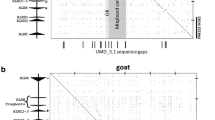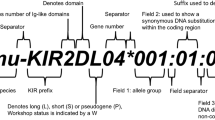Abstract
Killer immunoglobulin (Ig)-like receptors (KIRs) are the major functional natural killer (NK) cell receptors in human. The presence of KIR genes has only recently been demonstrated in other (non-primate) species, and their expression, genomic arrangement, and function in these species have yet to be investigated. In this study, we describe the KIR gene family in cattle. KIR sequences were amplified from cDNA derived from four animals. Seventeen new sequences were identified in total. Some are alleles of two previously described genes, and the remainder are representative of at least four additional genes. These cDNA data, together with analysis of the cattle genome sequence, confirm that, as in humans, cattle have multiple inhibitory and activating KIR genes, with variable haplotype composition, and putative framework genes. In contrast to human, the majority of the cattle KIR genes encode three Ig-domain KIRs; most of the inhibitory genes encode only one immunoreceptor tyrosine-based inhibitory motif (ITIM), and the activating genes encode molecules with arginine rather than the more usual lysine in the transmembrane domain. A divergent gene, 2DL1, encodes a two Ig-domain KIR with an unusual D0–D2 structure, and a distinct signaling domain with two ITIMs. Similarity to pig and human two Ig-domain (D0–D2) KIRs suggest these may be more related to an ancestral gene than the other cattle KIR genes. Cattle have multiple NKG2A-related genes and at least one Ly49 gene; thus, the data presented here suggest that they have the potential to express more major histocompatibility complex-binding NK receptors than other species.




Similar content being viewed by others
References
Abi-Rached L, Parham P (2005) Natural selection drives recurrent formation of activating KIR and Ly49 from inhibitory homologues. J Exp Med 201(8):1319–1332
Barten R, Torkar M, Haude A, Trowsdale J, Wilson MJ (2001) Divergent and convergent evolution of NK-cell receptors. Trends Immunol 22:52–57
Birch J, Ellis SA (2007) Complexity in the cattle CD94/NKG2 gene families. Immunogenetics 59(4):273–280
Birch J, Murphy L, MacHugh ND, Ellis SA (2006) Generation and maintenance of diversity in the cattle MHC class I region. Immunogenetics 58:670–679
Boysen P, Klevar S, Olsen I, Storset AK (2006a) The protozoan Neospora caninum directly triggers bovine NK cells to produce gamma interferon and to kill infected fibroblasts. Infect Immun 74(2):953–960
Boysen P, Olsen I, Berg I, Kulberg s, Johansen GM, Storset AK (2006b) Bovine CD2−/NKp46+ cells are fully functional natural killer cells with a high activation status. BMC Immunology 7:10
Denis M, Keen DL, Parlane NA, Storset AK, Buddle BM (2007) Bovine NK cells restrict the replication of Mycobacterium bovis in bovine macrophages and enhance IL-12 release by infected macrophages. Tuberculosis (Edinb) 87:53–62
Ellis SA, Holmes EC, Staines KA, Smith KB, Stear MJ, McKeever DJ, MacHugh ND, Morrison WI (1999) Variation in the number of expressed MHC genes in different cattle class I haplotypes. Immunogenetics 50:319–328
Hiby SE, Walker JJ, O’Shaughnessy KM, Redman CW, Carrington M, Trowsdale J, Moffett A (2004) Combinations of maternal KIR and fetal HLA-C genes influence the risk of preeclampsia and reproductive success. J Exp Med 200:957–965
Kikuchi-Maki A, Catina TL, Campbell KS (2005) KIR2DL4 transduces signals into human NK cells through association with the Fc receptor gamma protein. J Immunol 174:3859–3863
Marsh SG, Parham P, Dupont B, Geraghty DE, Trowsdale J, Middleton D, Vilches C, Carrington M, Witt C, Guethlin LA, Shilling H, Garcia CA, Hsu KC, Wain H (2003) KIR nomenclature report, 2002. Immunogentics 55:220–226
Martin AM, Kulski JK, Gaudieri S, Witt CS, Freitas EM, Trowsdale J, Christiansen FT (2004) Comparative genomic analysis, diversity and evolution of two KIR haplotypes A and B. Gene 335:121–131
McQueen KL, Wilhelm BT, Harden KD, Mager DL (2002) Evolution of NK receptors: a single Ly49 and multiple KIR genes in the cow. Eur J Immunol 32:810–817
Moretta L, Moretta M (2004) Killer immunoglobulin-like receptors. Curr Opin Immunol 16:626–633
Rajagopalan S, Long EO (2005) Understanding how combinations of HLA and KIR genes influence disease. J Exp Med 201:1025–1029
Sambrook JG, Bashirova A, Palmer S, Sims S, Trowsdale J, Abi-Rached L, Parham P, Carrington M, Beck S (2005) Single haplotype analysis demonstrates rapid evolution of the KIR loci in primates. Genome Res 15:25–35
Sambrook JG, Sehra H, Coggill P, Hunphray S, Palmer S, Sims S, Takamatsu H, Wileman T, Archibald A, Beck S (2006) Identification of a single killer immunoglobulin-like receptor (KIR) gene in the porcine leukocyte receptor complex on chromosome 6q. Immunogenetics 58:481–486
Stewart CA, Laugier-Anfossi F, Vely F, Saulquin X, Riedmuller J, Tisserant A, Gauthier L, Romagne F, Ferracci G, Arosa FA, Moretta A, Sun PD, Ugolini S, Vivier E (2005) Recognition of peptide-MHC class I complexes by activating killer immunoglobulin-like receptors. Proc Natl Acad Sci USA 102(37):13224–13229
Storset AK, Slettedal IO, Williams JL, Law A, Dissen E (2003) NK cell receptors in cattle: a bovine KIR-like receptor multigene family contains members with divergent signalling motifs. Eur J Immunol 33:980–990
Takahashi T, Yawata M, Raudsepp T, Lear TL, Chowdhary BP, Antczak DF, Kasahara M (2004) NK cell receptors in the horse: evidence for the existence of multiple transcribed Ly49 genes. Eur J Immunol 34:773–784
Trowsdale J (2001) Genetic and functional relationships between MHC and NK receptor genes. Immunity 15:363–374
Trundley AE, Hiby SE, Chang C, Sharkey AM, Santourlidis S, Uhrberg M, Trowsdale J, Moffett A (2006) Molecular characterization of KIR3DL3. Immunogenetics 57:904–916
Vilches C, Rajalingam R, Uhrberg M, Gardiner CM, Young NT, Parham P (2000) KIR2DL5, a novel KIR with a D0–D2 configuration of Ig-like domains. J Immunol 164:5797–5804
Wilson MJ, Torkar M, Haude A, Milne S, Jones T, Sheer D, Beck S, Trowsdale J (2000) Plasticity in the organisation and sequences of human KIR/ILT gene families. Proc Natl Acad Sci USA 97(9):4778–4783
Acknowledgments
This work was supported by the Biotechnology and Biological Sciences Research Council, UK. We would like to thank the staff of the IAH farm for maintenance of MHC-inbred animals, Helen Prentice for help with sampling, and James Birch for help with data analysis. The experiments carried out in this study comply with UK law.
Author information
Authors and Affiliations
Corresponding author
Rights and permissions
About this article
Cite this article
Dobromylskyj, M., Ellis, S. Complexity in cattle KIR genes: transcription and genome analysis. Immunogenetics 59, 463–472 (2007). https://doi.org/10.1007/s00251-007-0215-9
Received:
Accepted:
Published:
Issue Date:
DOI: https://doi.org/10.1007/s00251-007-0215-9




